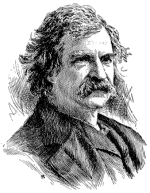The Boys’ Life of Mark Twain
by Paine

XLV. “The Adventures of Huckleberry Finn”
Meantime, Mark Twain had really become a publisher. His nephew by marriage, Charles L. Webster, who, with Osgood, had handled the “Mississippi” book, was now established under the firm name of Charles L. Webster & Co., Samuel L. Clemens being the company. Clemens had another book ready, and the new firm were to handle it throughout.
The new book was a story which Mark Twain had begun one day at Quarry Farm, nearly eight years before. It was to be a continuation of the adventures of Tom Sawyer and Huck Finn, especially of the latter as told by himself. But the author had no great opinion of the tale and presently laid it aside. Then some seven years later, after his trip down the river, he felt again the inspiration of the old days, and the story of Huck’s adventures had been continued and brought to a close. The author believed in it by this time, and the firm of Webster & Co. was really formed for the purpose of publishing it.
Mark Twain took an active interest in the process. From the pages of “Life” he selected an artist–a young man named E. W. Kemble, who would later become one of our foremost illustrators of Southern character. He also gave attention to the selection of the paper and the binding–even to the method of canvassing for the sales. In a note to Webster, he wrote:
“Get at your canvassing early and drive it with all your might . .
. . If we haven’t 40,000 subscriptions we simply postpone
publication till we’ve got them.”
Mark Twain was making himself believe that he was a business man, and in this instance, at least, he seems to have made no mistake. Some advanced chapters of “Huck” appeared serially in the “Century Magazine,” and the public was eager for more. By the time the “Century” chapters were finished the forty thousand advance subscriptions for the book had been taken, and Huck Finn’s own story, so long pushed aside and delayed, came grandly into its own. Many grown-up readers and most critics declared that it was greater than the “Tom Sawyer” book, though the younger readers generally like the first book the best, it being rather more in the juvenile vein. Huck’s story, in fact, was soon causing quite grown- up discussions–discussions as to its psychology and moral phases, matters which do not interest small people, who are always on Huck’s side in everything, and quite willing that he should take any risk of body or soul for the sake of Nigger Jim. Poor, vagrant Ben Blankenship, hiding his runaway negro in an Illinois swamp, could not dream that his humanity would one day supply the moral episode for an immortal book!
As literature, the story of “Huck Finn” holds a higher place than that of “Tom Sawyer.” As stories, they stand side by side, neither complete without the other, and both certain to live as long as there are real boys and girls to read them.
 Continue...
Continue...![[Buy at Amazon]](http://images.amazon.com/images/P/B0006AHKG6.01.MZZZZZZZ.jpg)